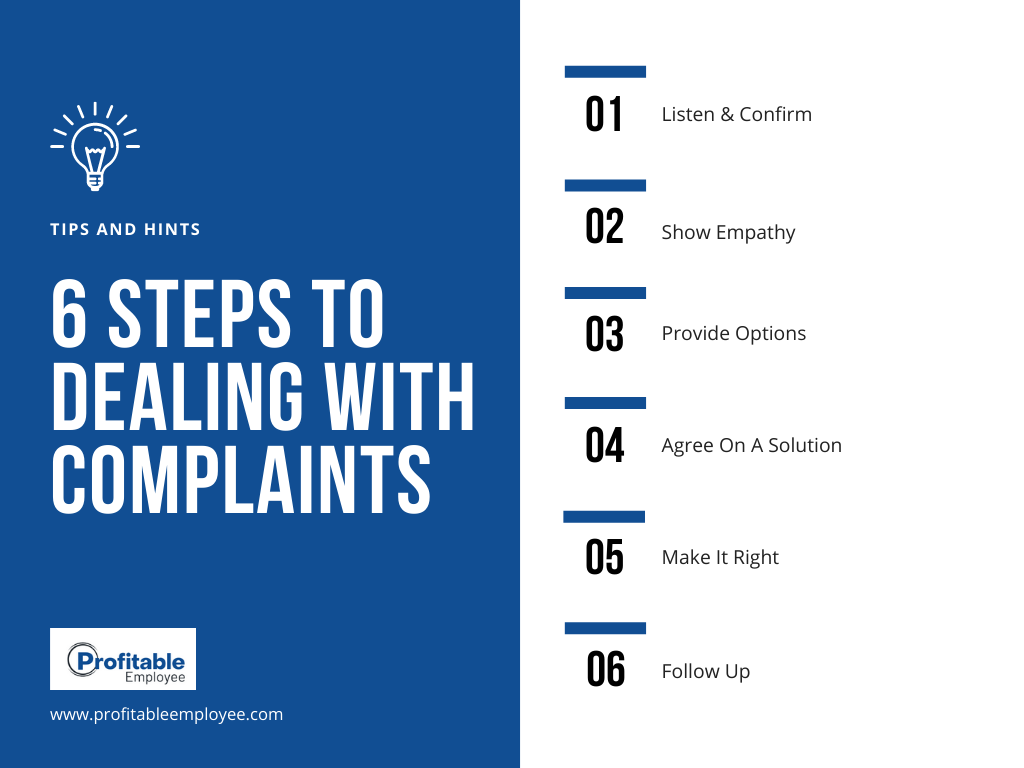Do your team know how to deal with customer complaints, and do they even care?
Do they have the confidence and competence to resolve issues, or do they prefer to avoid asking customers if they are satisfied 'because dealing with complaints is too hard'?
The reality is that managing customer complaints is not always easy, as customers can be overly demanding and even rude, and fixing complaints can take up a lot of time and effort.
However, if your business does not have an effective complaint handling process in place all you are doing is annoying customers and hurting your business.
The importance of dealing with complaints
Why do customers complain?
A common misconception is that complaining customers only want free stuff. But this is often not the case.
Example
Imagine you are sitting at a restaurant with your work colleagues for a quick meal over the lunch break. Everyone orders a meal, and all the meals arrive except for yours. You wait for a few minutes and finally ask the waiter where your meal is. The waiter goes to the kitchen to check.
Soon the waiter returns and apologises for the mistake, as the meal was left off the order. They then give you two options:
- They can cook the meal immediately
- They can give you a 20% discount next time you visit
Which one would you choose?
You want what you came for - you want the meal. And if they can't do that then there is little reason for you or your party to return, even with a 20% discount.
What employees need to do to resolve complaints
When customers complain they want the problem fixed as quickly as possible, and if you are either unwilling or unable to fix the problem then they want compensation.
How to encourage customer complaints
The first step to resolving a complaint is to become aware of it. But here lies the big challenge, as most customers are unlikely to complain directly to staff. Instead, they will leave unhappy with the experience and then go and post their feedback online and tell their friends.
This means that employees need to seek feedback during the customer's experience and not just at the end when they are paying the bill. If a complaint is only raised when the bill is being paid there is no opportunity to resolve the issue, meaning that all that can be done is to offer an apology and/or a discount.
Confidence and competence to manage complaints
To make sure that employees can effectively handle complaints they need to have:
Confidence in their own ability to manage each complaint. Confidence is built up over time through:
- personal experience.
- knowing that their managers will support them with any decisions they make.
Competence refers to having:
- Knowledge of what to do to handle the complaint and being aware of what they are authorised to do, and when they need to escalate it to management.
- Skills to be able to engage with the customer such as questioning, listening and problem solving.
The 6 'Make It Right' steps
When it comes to dealing with customer issues or complaints, we need to follow the 6-step ‘Make it Right’ process.

1. Listen & Confirm
The first step is to find out what the customer’s complaint is by listening. This means stopping everything you are doing and focusing your attention on the customer. Once you have heard the complaint you need to repeat it back to the customer to confirm that it has been understood
2. Show Empathy
When dealing with complaints you need to demonstrate that you understand how the customer is feeling. You do this by showing empathy in your tone of voice, by the words you use and by how you take the complaint seriously. When showing empathy.
When showing empathy, remember it is about the customer's experience and not yours. So, even if you don’t agree with their complaint:
- Don’t argue with them
- Don’t blame other staff members
- Don't tell them 'It's not your fault'
Most customers want their complaints to be resolved quickly by employees, and if they can’t then and only then do they want it to be escalated to management.
3. Provide Options
Now that you understand the complaint, you need to provide suitable options to resolve it.
When it comes to offering options, you need to be aware of what you are authorised to do or offer and when you need to escalate the complaint to management. Most often the solution may be a simple fix.
Example - Getting the kitchen to re-cook a steak, or get a hotter coffee
However, for more complex complaints or situations with limited options, you should offer one or two relevant options to the customer.
Example - Loud table in a full restaurant (i.e. Offer to talk to other tables and offer to move them when another table is free).

4. Agree On A Solution
Having given the customer options, you need to both agree on what works for both parties. The simple act of asking the customer to choose an option helps to reinforce that you care about their satisfaction.
Sometimes a customer will not be happy with the options they have been given, and when this happens you may need to repeat the steps to provide different options until the customer is happy.
5. Make It Right
The next step is to follow through with what was agreed and 'Make It Right’ for the customer. During this stage, it is important to keep the customer informed how long it will take, or if there are any delays.
6. Follow Up
The final stage is to follow up with the customer to make sure they are happy with the outcome.
This final stage also allows the employee to identify if the customer is happy, or if they need to escalate the customer issue to the manager.
So there we have it, the 6 easy steps to managing customer complaints. By following each of these steps, you increase the chances of ‘Making it Right’ for the customer and resolving their complaints quickly.
WHAT ARE YOUR THOUGHTS? DO YOU AGREE, OR DO YOU HAVE A DIFFERENT PERSPECTIVE? If so then leave your comments and feedback below

